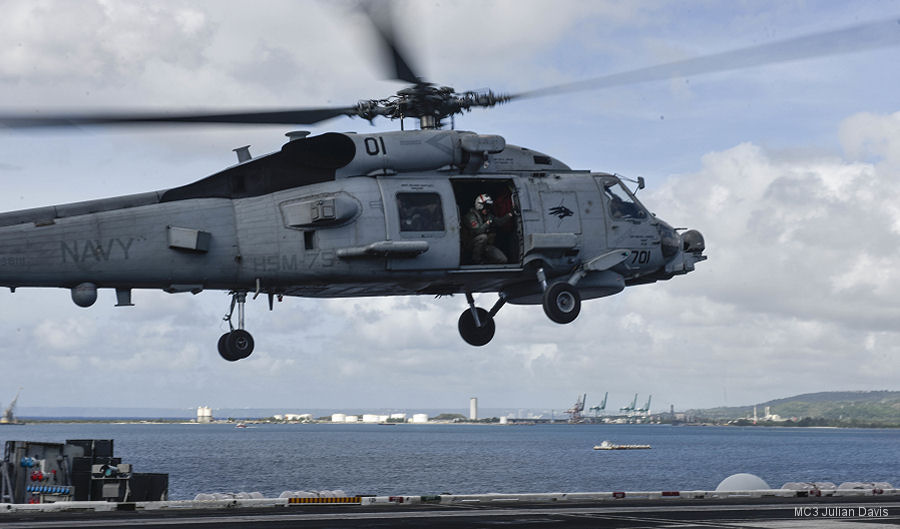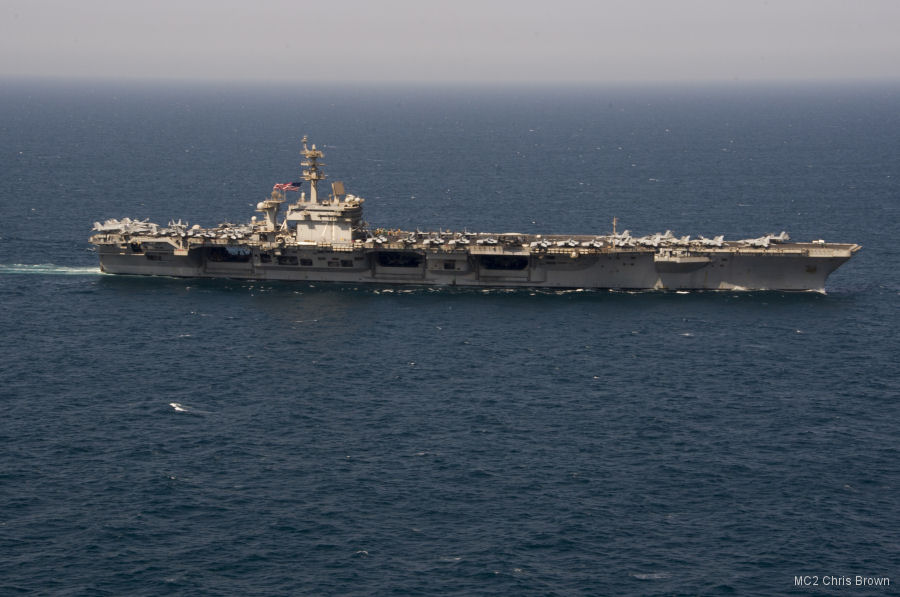
US Navy, May 27, 2020 - PHILIPPINE SEA by PO3 Conner Blake - The aircraft carrier USS Theodore Roosevelt (CVN 71) got underway May 21, marking a major milestone in its return to an operational status, however, Theodore Roosevelt’s helicopter squadrons attached to Carrier Air Wing (CVW) 11 were flying missions from the ship two weeks earlier, while the ship was still moored in Guam.
CVW-11 has two helicopter squadrons, the “Wolf Pack” of Helicopter Maritime Strike Squadron (HSM) 75 and the “Eightballers” of Helicopter Sea Combat Squadron (HSC) 8.
The squadrons support the carrier strike group with anti-submarine warfare, search and rescue, logistics and passenger transfer and a variety of other missions. Maintaining the squadrons’ operational status is a critical part of Carrier Strike Group (CSG) Nine’s ability to project power over the horizon.
“It started as soon as we got back aboard the ship,” said Cmdr. Eli Owre, commanding officer of HSM-75. “After we made sure the aircraft were ready to go, completing all required inspections, we performed ground turns, (maneuvering the aircraft around the flight deck), to make sure the aircraft would operate on deck before we put them in the air. Finally, we communicated with the ship and air-wing, putting together a safe plan of getting back to flight operations.”
Pilots assigned to HSM-75 fly the MH-60R Sea Hawk and specialize in anti-surface and anti-submarine warfare missions. With some of the pilots still current on their qualifications, the squadron was able to begin flying immediately, even with the ship moored at Naval Base Guam ensuring they retained the proficiencies and capabilities when the ship and crew returned to sea.
“Having those current qualifications was critical to our ability to immediately resume flying,” said Owre. “This being our second week of day and night flight operations, those qualifications gave us the opportunity to keep everyone up-to-date and make for a safer transition from flight operations moored to flight operations at sea.”
While Sailors assigned to HSM-75 conduct flight operations, they are also learning to live and work under a new standard operating procedure to prevent and mitigate the spread of COVID-19.
“We are adhering to the same standards that everyone else on the ship is,” said Owre. “There are the typical growing pains because its unusual wearing a mask while working on the aircraft or anything of that nature, but our Sailors are adapting. The sooner we get back to work, the sooner the new normal melds into the everyday process,” said Owre.
According to Lt. Cmdr. John Zilai, operations officer of HSM-75, being operational is not just good for the squadron, but it is good for the individual Sailor as well. “We’re here to operate,” said Zilai. “We’re here to fly aircraft, and we’re here to maintain aircraft. Part of the push to get operating again was to regain a level of normal again for our Sailors so when they send an email home they can talk about what they are doing rather than what they wish they did.”
The Wolf Pack, Theodore Roosevelt and the other squadrons of CVW-11 are back underway in the Philippine Sea requalifying their fixed-wing pilots; all the while continuing to win the fight against an unseen enemy. While the fight has been challenging, full of ups and downs and a lot of questions, the Sailors embarked on Theodore Roosevelt are applying the resiliency and teamwork that brought them together during the uncertainty, to their task of returning the squadron to an operational status.
“The fact that we are able to launch again is a credit to the teamwork and resilience our Sailors have shown coming back to work following their quarantine,” said Owre. “Any time we launch, it’s an all hands effort.”
Zilai says the hard work, training and incremental steps HSM-75 has taken to become operational again can be measured and used to help commands maintain their operational status in the future should they have similar COVID experiences.
“If this is the world we live in now, I think we have a lot of things that we tried that worked and hopefully people can learn from that,” said Zilai. “From a helicopter standpoint, if another ship has a similar COVID situation, maybe they will remember how Theodore Roosevelt and CVW-11 were able to keep flying helicopters and they too will be inspired to fight on.”
Theodore Roosevelt is the nation’s fourth Nimitz-class aircraft carrier with a crew of nearly 5,000 Sailors who support and conduct air operations at sea. Theodore Roosevelt departed San Diego for a scheduled Indo-Pacific deployment January 17.
CVW-11 has two helicopter squadrons, the “Wolf Pack” of Helicopter Maritime Strike Squadron (HSM) 75 and the “Eightballers” of Helicopter Sea Combat Squadron (HSC) 8.
The squadrons support the carrier strike group with anti-submarine warfare, search and rescue, logistics and passenger transfer and a variety of other missions. Maintaining the squadrons’ operational status is a critical part of Carrier Strike Group (CSG) Nine’s ability to project power over the horizon.
“It started as soon as we got back aboard the ship,” said Cmdr. Eli Owre, commanding officer of HSM-75. “After we made sure the aircraft were ready to go, completing all required inspections, we performed ground turns, (maneuvering the aircraft around the flight deck), to make sure the aircraft would operate on deck before we put them in the air. Finally, we communicated with the ship and air-wing, putting together a safe plan of getting back to flight operations.”
Pilots assigned to HSM-75 fly the MH-60R Sea Hawk and specialize in anti-surface and anti-submarine warfare missions. With some of the pilots still current on their qualifications, the squadron was able to begin flying immediately, even with the ship moored at Naval Base Guam ensuring they retained the proficiencies and capabilities when the ship and crew returned to sea.
“Having those current qualifications was critical to our ability to immediately resume flying,” said Owre. “This being our second week of day and night flight operations, those qualifications gave us the opportunity to keep everyone up-to-date and make for a safer transition from flight operations moored to flight operations at sea.”
While Sailors assigned to HSM-75 conduct flight operations, they are also learning to live and work under a new standard operating procedure to prevent and mitigate the spread of COVID-19.
“We are adhering to the same standards that everyone else on the ship is,” said Owre. “There are the typical growing pains because its unusual wearing a mask while working on the aircraft or anything of that nature, but our Sailors are adapting. The sooner we get back to work, the sooner the new normal melds into the everyday process,” said Owre.
According to Lt. Cmdr. John Zilai, operations officer of HSM-75, being operational is not just good for the squadron, but it is good for the individual Sailor as well. “We’re here to operate,” said Zilai. “We’re here to fly aircraft, and we’re here to maintain aircraft. Part of the push to get operating again was to regain a level of normal again for our Sailors so when they send an email home they can talk about what they are doing rather than what they wish they did.”
The Wolf Pack, Theodore Roosevelt and the other squadrons of CVW-11 are back underway in the Philippine Sea requalifying their fixed-wing pilots; all the while continuing to win the fight against an unseen enemy. While the fight has been challenging, full of ups and downs and a lot of questions, the Sailors embarked on Theodore Roosevelt are applying the resiliency and teamwork that brought them together during the uncertainty, to their task of returning the squadron to an operational status.
“The fact that we are able to launch again is a credit to the teamwork and resilience our Sailors have shown coming back to work following their quarantine,” said Owre. “Any time we launch, it’s an all hands effort.”
Zilai says the hard work, training and incremental steps HSM-75 has taken to become operational again can be measured and used to help commands maintain their operational status in the future should they have similar COVID experiences.
“If this is the world we live in now, I think we have a lot of things that we tried that worked and hopefully people can learn from that,” said Zilai. “From a helicopter standpoint, if another ship has a similar COVID situation, maybe they will remember how Theodore Roosevelt and CVW-11 were able to keep flying helicopters and they too will be inspired to fight on.”
Theodore Roosevelt is the nation’s fourth Nimitz-class aircraft carrier with a crew of nearly 5,000 Sailors who support and conduct air operations at sea. Theodore Roosevelt departed San Diego for a scheduled Indo-Pacific deployment January 17.

Comments | Join community |
| Good to have helis - also for boarding missions . . . |
| Happy for the sailors to be back on duty again after spending weeks in Guam following a major coronavirus outbreak on board. |
See also |
List of Coronavirus outbreak
HSM-75
HSC-8




